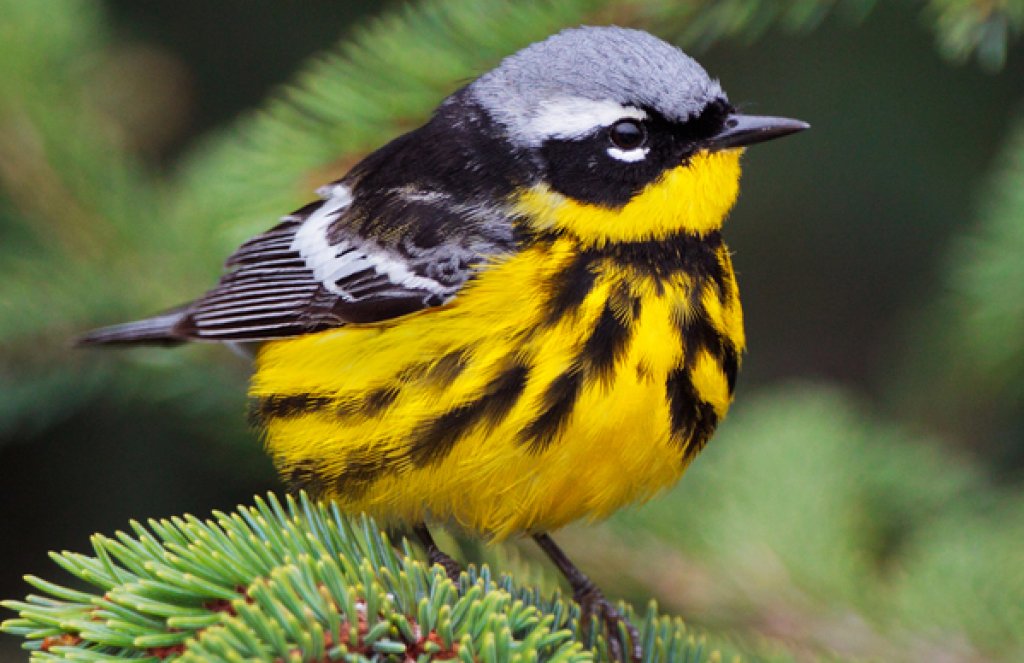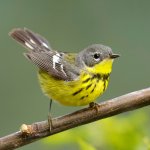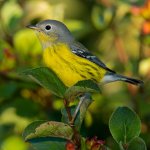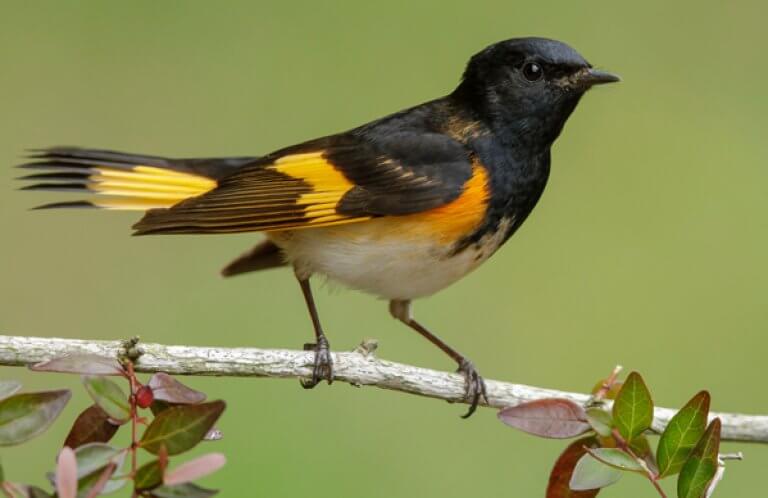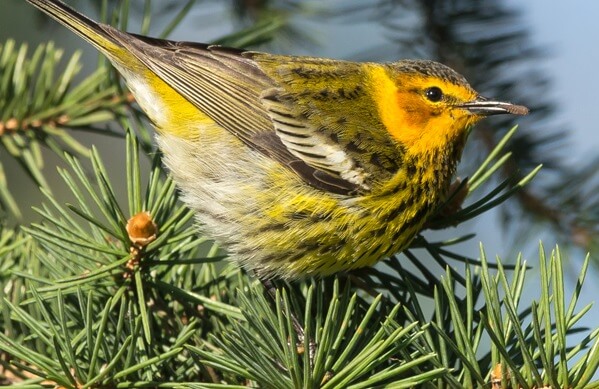About the Magnolia Warbler
The active, confiding Magnolia Warbler is fairly easy to find during its biannual migrations through the eastern and central United States. The male is especially eye-catching — a combination of bright yellow and black, with striking white wing and tail patches. Female and juvenile "maggies" are similarly colored, but in more muted tones.
Magnolia Warblers of all ages show a unique tail pattern. Seen from below (often the only look birdwatchers get!) the white tail shows a wide black tip, looking as if the bottom third was dipped in ink. From above, white patches on the Magnolia's otherwise-dark tail frame what resembles a blackish “T” pattern, especially noticeable when the bird spreads its tail — a habit typical of another flashy warbler, the American Redstart.
Mississippi Misnomer
Ornithologist Alexander Wilson first described this species in 1810, based on a specimen he collected from a magnolia tree in Mississippi, no doubt during migration. Although he used "Black-and-yellow Warbler" as the bird's English name, it was the Latin species name, “magnolia,” that stuck. A more accurate name for the Magnolia Warbler would be the “Spruce Warbler,” after its favored boreal nesting habitat. The Magnolia shares its northern breeding grounds with a number of other colorful warbler species, including the Bay-breasted, Canada, and Blackburnian.
Songs and Sounds
The male Magnolia Warbler sings a hurried but rich “weeter-weeter-weetet” or "weeta-weeta-weeteo," which sounds a bit like an abbreviated Hooded Warbler. Male Magnolias sing two different song types: one for courtship and the other to mark their territories.
Listen here:
Compare to a Hooded Warbler:
Breeding and Feeding
Courtship in the Conifers
Male Magnolia Warblers arrive on the breeding grounds ahead of females, and immediately begin to establish territories by singing, displaying, and chasing rival males. They display by spreading wings and tail to flash the white markings; this behavior is used both to court potential mates and warn off intruding males. When a female enters his territory, a male follows her from branch to branch while displaying. The female may also display in kind.
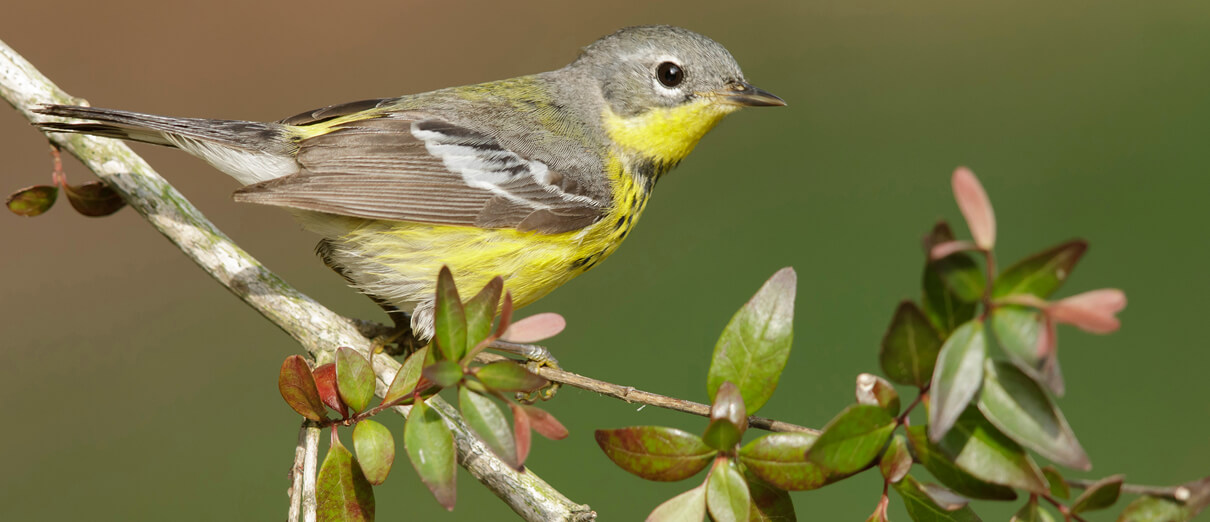
Once mated, the female Magnolia begins to construct her nest, usually low in a thick stand of young conifers. The well-concealed structure is a shallow cup made of grasses, weed stalks, and twigs. The female does most of the building, then incubates her clutch of four eggs without assistance from the male. However, both parents feed the young. After fledging, juvenile Magnolias wander from their home territory, eventually joining small groups of warblers and other small birds before migration begins.
Caterpillar Connoisseur
Insectivorous like all of its kin, the Magnolia Warbler feeds heavily on protein-rich insects and spiders, particularly caterpillars. Like other boreal-nesting species such as Cape May and Blackpoll Warblers, it exploits periodic outbreaks of spruce budworms while on its breeding grounds. This species often forages low in shrubs or even on the ground, gleaning leaves and stems for prey, and also sometimes hovering to grab a choice target. Ever the dietary opportunist (like many species), the Magnolia Warbler adds small fruits and berries to its diet during migration and on the wintering grounds.
Region and Range
Over 70 percent of the Magnolia Warbler population breeds in boreal forests, mainly in Canada, but also in the Great Lakes region, New England, and the northern Appalachians.
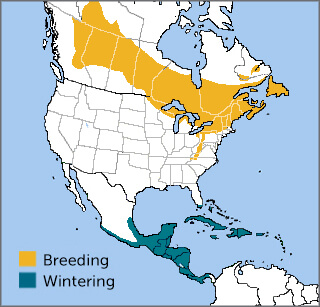
Like many Neotropical migrants, the Magnolia Warbler migrates at night, mostly east of the Great Plains, although it is a rare but regular vagrant to the western U.S. Its southbound journey takes it across the Gulf of Mexico to wintering grounds in Mexico, Central America, and the Caribbean, where it occupies a wide variety of leafy habitats, from forests and scrub to agroforestry settings including shade coffee, cacao, and citrus farms. There, it shares space with resident birds and other Neotropical migrants such as the Summer Tanager and Wood Thrush.
Although this species commonly joins mixed-species flocks during migration and on its wintering grounds, it stays separate from other Magnolia Warblers, and both males and females aggressively defend individual feeding territories during the winter.
Conservation of the Magnolia Warbler
Although the Magnolia Warbler population is considered stable, these birds are often victims of collisions with glass, communications towers, and other human-made structures, especially during migration. Deforestation on nesting and wintering grounds is also a threat.

Help support ABC's conservation mission!
ABC's Collisions program provides solutions to prevent bird collisions with glass, particularly at home windows. We also provide tools to prevent fatal bird/communications tower collisions. The Magnolia Warbler benefits from ABC's efforts to "bring back the birds," with our focus on conserving geographically linked habitats: boreal forests where these birds breed, and places where they overwinter. ABC is working with partners to help manage these lands, both for birds and people.
Get Involved
Policies enacted by the U.S. Congress and federal agencies, such as the U.S. Fish and Wildlife Service, have a huge impact on migratory birds. You can help shape these rules for the better by telling lawmakers to prioritize birds, bird habitat, and bird-friendly measures. To get started, visit ABC's Action Center.
Living a bird-friendly life can have an immediate impact on migratory birds in the United States. Doing so can be as easy as adding native plants to your garden, avoiding pesticides, and keeping cats indoors. To learn more, visit our Bird-Friendly Life page.
American Bird Conservancy and our Migratory Bird Joint Venture partners have improved conservation management on more than 6.4 million acres of U.S. bird habitat — an area larger than the state of Maryland — over the last ten years. That's not all: With the help of international partners, we've established a network of more than 100 areas of priority bird habitat across the Americas, helping to ensure that birds' needs are met during all stages of their lifecycles. These are monumental undertakings, requiring the support of many, and you can help by making a gift today.





































